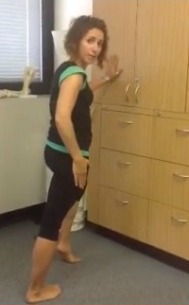I’ve always been fascinated with what I’ve learned from my injuries. Of course, it helps that I have a great physiotherapist who is very professional and supportive. His name is Andres Povea and we have been working together for over 15 years.
One of the discoveries I’ve made through my injuries is that the “flexibility myth” is just that… a MYTH!
The myth is that our flexibility is directly related to the length of our muscles. As it turns out, this is not so.
The Flexibility Myth and Flexibility Exercises for Dancers
But before we go into what makes a dancer flexible or not, let’s take a look at a part of our bodies that is basic in understanding flexibility. Lisa Howell from Perfect Form Physio and The Ballet Blog is another physiotherapist I trust and follow. Below she explains what the fascia is and how it relates to your flexibility.
Most people learn anatomy by learning about the bones and the muscles that attach to them. This is a good start, but is not really an accurate picture of our true anatomy. We are not just a skeleton held together with muscles and ligaments. A better picture is to imagine a mass of tissues including muscles, bones and ligaments, bound together, organized and coordinated by a complex web of fascia.
Imagine your fascia as looking like an enormous spider web that covers over every one of your muscles and links it to the next one. It intertwines with everything in your body, including your stomach, your lungs, your eyes and your toes.
If you have ever seen a raw chicken before it is prepared for cooking, you may remember an iridescent layer between the flesh of the muscles and the skin. This is the fascia of the chicken, and it looks pretty much the same in humans!
http://www.theballetblog.com/article/articles/flexibility/what-is-fascial-tension/
The Flexibility Myth and Flexibility Exercises for Dancers
So now to our flexibility exercises for dancers, also known as “fascial mobilizing techniques.”
I have seen (and felt) such amazing results with working on the fascial system that I had to find a way to teach this to the world. The myth of flexibility having anything to do with “Short Muscles” has been promoted for far too long, and it is time that some more effective, more truthful and more intelligent techniques are used to achieve our potential!
We have recently posted 3 videos all about fascial mobility and some readers have been asking about why it works so well!
This short video by Lisa Howell from The Ballet Blog will give you an understanding of just why these seemingly simple techniques can have such a great effect on your mobility.
There are lots of different fascial mobilizing techniques that you can use to get more mobile – including the one[s] demonstrated in the following videos by one of our therapists, Sally Harrison.
Video courtesy of Lisa Howell.
We are a high level performance based clinic, specializing in the treatment and education of dancers and other athletes. This exercise is the first of a set of 3 fascial mobilizers that you can add into your flexibility program to enhance your flexibility safely!
www.perfectformphysio.com.au
Thanks to Lisa Howell from Perfect Form Physio and The Ballet Blog.
Video from Lisa Howell‘s YouTube channel.
Video courtesy of Perfect Form Physio and The Ballet Blog.
The Flexibility Myth and Flexibility Exercises for Dancers
Remember to:
6. Focus on the mobility of your spine
If you’d like to learn more of the system of connective tissue, fascia, also read:
Give the flexibility exercises above a try and share with us your results!
[jazzyoptin]



